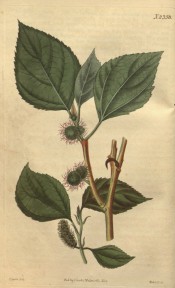Broussonetia papyrifera Vent.
Large dioecious shrub or tree with woolly shoots and leaves, variable toothed leaves. The female plant is quite attractive with its fruit aggregated into a small orange, woolly mass. To 10m or more under favourable conditions. There are a number of garden forms. [RHSD, Hilliers’, Hortus].
Horticultural & Botanical History
‘The Paper-Mulberry tree is a shrub of but little beauty; but, both in Japan and in the South-sea islands, is of the utmost importance for economical purposes. In Otaheite, as we are informed by Captain Cook, in his relation of his first voyage, the finest and whitest cloth worn by the chiefs and principal persons of the island is entirely manufactured from the inner bark of this tree by a simple process of beating; and in Japan the same species is cultivated in great quantity, for the purpose of making paper of different kinds, by a process in which the bark is reduced to a pulp, to be afterwards spread into sheets of greater or less thickness, upon similar principles, though by different contrivances, to what are used in the manufacture of European paper, except that it appears that the Japanese employ vegetable mucilages only, and neither animal gluten nor alum, which is probably the reason that their paper is more bibulous than ours. A full description of the Japanese process for making paper from the Paper-Mulberry may be seen in Kaempfer’s amaenitates, which has been translated into several of the Encyclopaedias and Dictionaries of the day. In young plants the leaves are more or less divided into lobes, but in adult shrubs they are generally entire, as seen in our plate, in which the upper figure represents a flowering branch of the female, and the lower one of a male plant. This tree has been long cultivated in our gardens; according to the Hortus Kewensis before 1751, by Peter Collinson, Esq. It appears by M. Poiret’s account in Lamarck’s Encyclopédie it had been long cultivated also in the Paris gardens, but that the male plant only was known, till M. Broussonet, in his travels, met with the female in some garden in Scotland, and transmitted cuttings of it. The fruit being from that time known, it was found not to belong to the genus Morus, though nearly allied to it. M. L’ Heretier gave it the name of Broussonetia; but his unfortunate death prevented its publication, till adopted by Ventenat, in his Tableau du Règne Végétal. Native of Japan and the South-sea islands. Flowers from February to September. Propagated by layers, cuttings, or seed. Communicated by John Walker, Esq.’ [BM t.2358/23].
‘This most important plant in the paper industry, since the strongest and greatest amount of paper is made from its bark, comes from China, but has been cultivated for a long time in all the provinces of Japan south of the Tsugaru Straits, except on the fertile plains. It is found in mountain valleys, along the roads, on the narrow ridges which separate the terraced rice-fields from each other, on river dams, where its bushes, as willows with us, help to make them firm, it is also cultivated in dry fields, not seldom alternating in rows with the white mulberry or tea bush. In Iyo, on the island of Shikoku, where the paper mulberry, just as in the neighbouring province of Tosa, is raised frequently on the hill sides, it appears as an undergrowth between the rows of sumachs. Only rarely does one find a piece of good arable land exclusively devoted to a plantation of Broussonetia bushes. I speak here of bushes, and emphasize the fact that I met the plant as a tree in Japan only in the rarest instance, e.g. in the Botanical Garden. Its cultivation for the paper industry resembles our treatment of basket willows. Its propagation is by means of slips.’ [Rein - The Industries of Japan p.393/1889].
History at Camden Park
Broussonetia papyrifera is marked with a ‘c’ in an 1836 edition of Loddiges’ catalogue held at Camden Park [CPA]. In William Macarthur’s code, used and explained elsewhere, this means grown at Camden. It is almost certain that it was grown in the gardens around this time but may have been short lived as it did not appear in the catalogues. Probably introduced to assess its industrial potential.
Notes
Published Apr 01, 2010 - 05:40 PM | Last updated Apr 01, 2010 - 05:47 PM
| Family | Moraceae |
|---|---|
| Category | |
| Region of origin | China |
| Synonyms |
|
| Common Name | Paper mulberry |
| Name in the Camden Park Record |
Broussonetia papyrifera |
| Confidence level | high |
